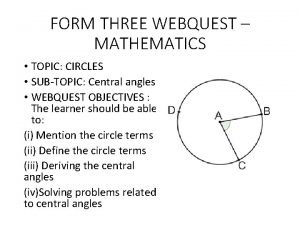INTRODUCING LAW 1 TOPIC THREE CONTENTS OF THE


















- Slides: 18

INTRODUCING LAW 1 TOPIC THREE

CONTENTS OF THE PRESENTATION l 2 Classifications or Divisions of Law

CLASSIFICATIONS OR DIVISIONS OF LAW There are many ways to classify laws. Law may be distinguished into the following: l Civil law and Criminal Law l Public Law and Private Law l Public International Law and Private International Law l Substantive and Procedural Law l Case Law and Statute Law l Common Law and Equity l Municipal Law and International Law l Islamic Law and Customary Law l Written Law and Unwritten Law (Formal and Informal) l 3

CLASSIFICATIONS AND DIVISIONS OF LAW 4 CIVIL LAW VS. CRIMINAL LAW l Civil law is that branch of law primarily concerned with the rights and duties of individuals towards each other. It includes for instance the law of contract, tort, property law, the law of succession and family law. l Law of Contract: deals with that branch of the law which determines whether a promise is legally enforceable and what are its legal consequences. l Law of Tort: a tort is defined as a civil wrong for which the remedy is a common law action for unliquidated (i. e. unspecified or unascertained damages and which is not exclusively the breach of a contract or breach of trust or other merely equitable obligation. Examples of torts are: nuisance, negligence, defamation and trespass.

CLASSIFICATIONS AND DIVISIONS OF LAW l l 5 Law of Property is that part of the law which determines the nature and extents of the rights which people may enjoy over land other property – for example, rights of ownership of land, or rights under a lease. Law of Succession is that part of the law which determines the devolution of property on the death of the former owner. Family Law is that branch of the law which defines the rights, duties and status of husband wife, parent and child and other members of a household. Civil law involves violations of agreements & civil wrongs through commission of an act or omission in which civil proceeding is instituted by the aggrieved person himself and not the State.

CLASSIFICATIONS AND DIVISIONS OF LAW l l l 6 Criminal law on the other hand is that part of law which characterizes certain kinds of wrong doing as offences or crimes against the State not necessarily violating any private rights and punishable by the State. Crime is defined as an act of disobedience of the law forbidden under pain of punishment. The punishment for crimes ranges from death or imprisonment to a money penalty (fine) or absolute discharge. For example, to commit murder is an offence against the State because it disturbs the public peace and security, so the action is brought by the State and not the victim.

CLASSIFICATIONS AND DIVISIONS OF LAW l l l 7 The police are the public servant whose duty is the prevention and detection of crime and the prosecution of offenders before the courts of law. Private citizens may legally enforce the criminal law by beginning proceedings themselves, but except in minor cases of common assault, rarely do so in practice. In Uganda, it is the State that decide which offence may be considered as crime and also legislate on such acts and prescribe punishments for such offences.

CLASSIFICATIONS AND DIVISIONS OF LAW 8 Distinction between Criminal Law and Civil Law 1. Nature of Proceeding l Criminal – initiated by the State through their agents like the Police or Attorney General under the office of the DPP. l Civil – initiated by the person who feels aggrieved by the act of another. l There may be instances where private individual can institute criminal proceedings. 2. Initiator of Proceeding l Criminal proceeding – the initiator is called the Prosecutor against a person called the accused. l Civil proceeding – the initiator is called the plaintiff against a person called the defendant(s).

CLASSIFICATIONS AND DIVISIONS OF LAW 3. l l 4. l l 5. l 9 l Proof of Proceeding Civil proceeding – proof beyond balance of probability Criminal proceeding – proof beyond reasonable doubt Objective of Proceeding Civil proceeding – the aim of the plaintiff is to seek compensation for damages caused to him. This is achieved through award of damages by the court. Criminal proceeding – the objective is punishment. This may be in the form of serving a prison term or payment of fine or both. Enforcement of Judgment Criminal proceeding – enforced by the State automatically Civil proceeding – the winner will need to apply for enforcement.

CLASSIFICATIONS AND DIVISIONS OF LAW 10 PUBLIC VS. PRIVATE l Public law refers to that branch of law which governs the relationship of the citizens and the State. It mainly includes constitutional law, criminal law and administrative law. l Constitutional Law has been defined as the rules which regulate the structure of the principal organs of government and their relationship to each other and determine their principal functions. This subject includes the constitution of legislature, power and privileges of members of parliament, the status of ministers, the civil service, the armed forces, the police, the relations between the central government and local authorities, the making of treaties, admission and rights of aliens, the courts of justice, liberties of speech, of meeting, of association and voting rights. Etc.

CLASSIFICATIONS AND DIVISIONS OF LAW l l 11 Administrative Law is defined as the body of legal principles which concerns the rights and duties arising from the impact upon the individual of the actual functioning of the executive instruments of government. For example administrative law determines the legal rights of a private citizen whose house a local authority intends to acquire compulsorily. Private law on the other hand refers to such laws that regulate legal relationship between or among private individuals. It includes contract law, family law among others.

CLASSIFICATIONS AND DIVISIONS OF LAW PUBLIC INTERNATIONAL LAW VS. PRIVATE INTERNATIONAL LAW l Public International Law refers to law dealing with bilateral relationships between two or more States (Nations) which is mostly done through international treaty, conventions, international custom and rule of civilized nations. l Private International Law relates to different types of laws to be applied during conflicts. E. g. conflict between Nigerian and Ugandan Laws on business transaction 12

CLASSIFICATIONS AND DIVISIONS OF LAW 13 SUBSTANTIVE LAW VS. PROCEDURAL LAW l Substantive law creates, defines, and regulates the rights, duties and powers of parties. Substantive law includes for example criminal law. l The substantive aspect of criminal law is found in the Penal Code which spelt out what offence is and what punishment should be given for each offence. Other examples include constitutional law, contract law, land law and family law. l Procedural law on the other hand lays down the mechanism or procedures through which the rights granted by substantive law may be enforced. CASE LAW VS. STATUTE LAW l Case law is sometimes called JP. It is not enacted but found in the collection of reported cases. It is judge-made law.

CLASSIFICATIONS AND DIVISIONS OF LAW Statute laws or legislations are laws enacted by a legislative or lawmaking body. l In Uganda, Statute laws include all laws enacted by the Parliament. Any positive enactment to which the State gives the force of law is a statute. COMMON LAW VS. EQUITY l Common Law is the law developed by the old common law courts of England. These courts include King’s Bench, Court of Common Pleas and Court of Exchequer. l Equity is the law developed by the old English Court of Chancery as a result of hardship created by Common Law. Whenever hardship was created by Common Law to any indigene, he could write a petition to the Lord Chancellor in the Chancery Court. l The Lord Chancellor granted relief on the principles of fairness, just and equitable basis. Common Law and Equity now fused. l 14

CLASSIFICATIONS AND DIVISIONS OF LAW 15 MUNICIPAL LAW VS. INTERNATIONAL LAW l Municipal law is the law of a country which applies within a State and regulates the relationships among the citizens and government or government agencies. Thus it is a combination of private and public law. l International Law on the other hand refers to a body of rules and principles which govern and are binding to all states in their relation to another. It includes for example, law governing sea, space among others. ISLAMIC LAW VS. CUSTOMARY LAW l Islamic Law is the law of Almighty Allah which was revealed to the Holy Prophet Muhammad (PBUH) through Angel Gabriel. This law is applicable to Muslims only. Its sources are Holy Qur’an, Hadith, Ijma (Consensus of Opinion) and Qiyas (Analogy)

CLASSIFICATIONS AND DIVISIONS OF LAW Customary law means a law relating to custom or usage of a given community. l It emerges from the traditional usage or practice of a people in a given community which by common adoption and acquiescence on their part and by long and unvarying habits have acquired to some extent element of compulsory and force of law with reference to the community. WRITTEN LAW VS. UNWRITTEN LAW l Written law is the law enacted in statute. This can either be done through legislative processes under a democratic government or military administration. l Unwritten law is a law which though never enacted in the form of statute or ordinance but has the sanction of custom. l 16

17

18
 General topic example
General topic example Topic down
Topic down Newton's first law and second law and third law
Newton's first law and second law and third law Newton's first law
Newton's first law V=k/p
V=k/p P=k/v
P=k/v What is the topic of the song
What is the topic of the song Agenda topic
Agenda topic Signal phrases to introduce quotes
Signal phrases to introduce quotes A concise introduction to linguistics
A concise introduction to linguistics Introducing james joyce
Introducing james joyce How to introduce a quote sentence starters
How to introduce a quote sentence starters What is a counterclaim in argumentative writing
What is a counterclaim in argumentative writing Introduce yourself interview
Introduce yourself interview Talk boost tracker
Talk boost tracker Ma
Ma Literary terms in poetry
Literary terms in poetry Introduction digestive system
Introduction digestive system Background of kfc company
Background of kfc company



































